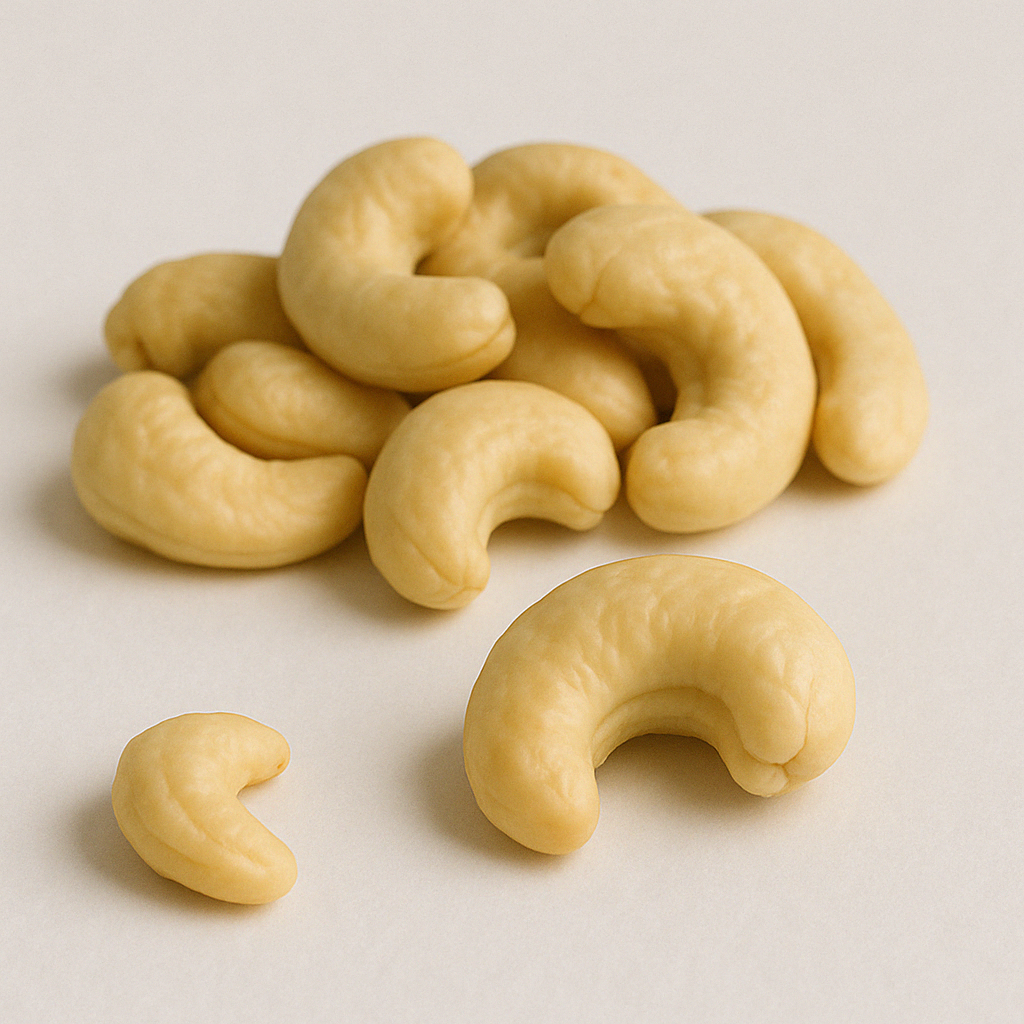
캐슈넛 from 가나
Featured manufacturers
/132x132/company-logo/0c/ea/bd/0ceabdf1e2f90baba359f6f430e19dcdd7bfdbdc/SOMMA_LOGO.png)
About this market
About
History
Cashew trees were introduced to Ghana in the 1960s as part of afforestation efforts and to control erosion. By the 1990s, cashew became increasingly commercialized due to rising export demand. Production gained momentum in the early 2000s with support from the Ghana Export Promotion Authority (GEPA) and international development agencies. In 2016, the Tree Crops Development Authority (TCDA) was established to oversee non-traditional crops like cashew. Today, cashew ranks among Ghana’s top non-traditional agricultural exports, with a focus on increasing value-added processing locally.
Production Regions
Cashew is mainly grown in Ghana’s northern and central belt:
- Brong-Ahafo Region: Largest production zone, particularly in Techiman and Wenchi districts.
- Northern Region: Including Yendi and Tamale; significant expansion due to suitable climate and land availability.
- Upper West Region: Important for smallholder cultivation, contributing to rural livelihoods.
- Volta & Eastern Regions: Emerging production areas with increasing private sector investment.
Growing Conditions
Cashew thrives in Ghana’s dry savannah and transitional zones:
- Climate: Hot semi-arid with distinct wet and dry seasons.
- Temperature: Ideal between 24–32°C.
- Rainfall: Requires 800–1,200 mm annually.
- Soil: Prefers sandy loam with good drainage; slightly acidic to neutral pH (5.5–6.5).
- Altitude: Grown up to 600 meters above sea level.
Harvesting Process
Cashew nuts are harvested manually after the fruit naturally drops to the ground:
- Maturity Indicators: Apple turns red/yellow; nut detaches cleanly.
- Collection & Drying: Nuts are sun-dried for 2–3 days to reduce moisture below 10%.
- Sorting & Bagging: Hand-sorted by size and defect; bagged in jute sacks for storage or export.
Cultivation Method
Most cashew farmers in Ghana are smallholders with 1–5 ha of land:
- Spacing: Trees planted at 8x8 or 10x10 m spacing.
- Pest Control: Use of integrated pest management for tea mosquito bug and powdery mildew.
- Pruning & Weeding: Regular canopy management and manual weeding to boost airflow and productivity.
- Fertilization: Organic compost or limited use of NPK fertilizers, depending on farmer resources.
Supply Chain
Ghana’s cashew supply chain is evolving:
- Producers: Dominated by smallholders; increasingly organized into farmer cooperatives.
- Middlemen & Traders: Bulk of raw nuts are aggregated by local traders for export.
- Exporters: Licensed buyers and exporters ship raw nuts primarily to Asia.
- Local Processors: Still limited; some private processors operate in Brong-Ahafo and Eastern regions.
Local Logistics
- Collection Points: Aggregation centers near farm gates or rural markets.
- Transport: Nuts are transported in open trucks or pickups to warehouses or ports.
- Warehousing: Dry, ventilated storage required to preserve quality before export.
- Export Ports: Port of Tema: Main sea route for cashew exports. Port of Takoradi: Secondary outlet, especially for exporters in the western corridor.
Regulations and Certifications
- Phytosanitary Certificates: Issued by Ghana’s Plant Protection and Regulatory Services.
- Export Permits: Required through GEPA and Customs.
- Traceability: Increasing focus through cooperative registration and buyer programs.
- Certifications: Fairtrade and Organic: Gaining traction for kernel exports. HACCP and ISO: For processors seeking EU and US market entry.
Quality Standards
Key parameters for raw nut exports:
- Nut Count: 180–200 per kg (lower is better).
- Moisture: Below 10%.
- Out-turn Ratio (OTR): 48–52 lbs per 80 kg bag.
- Appearance: Clean, whole nuts, free of infestation and mold.
Trade Terms
- MOQ: 10–20 metric tons for container loads.
- Incoterms: FOB (Tema), CIF (Mumbai, Ho Chi Minh, Hamburg).
- Payment: Bank transfers, letters of credit; some cash-in-advance for smaller volumes.
Environmental and Social Impacts
Cashew farming contributes positively in Ghana:
- Drought Tolerance: Suitable for semi-arid lands with low water use.
- Land Reclamation: Used in reforestation and erosion control.
- Rural Livelihoods: Significant income for over 100,000 smallholder households.
- Challenges: Farmer training, price volatility, and limited access to finance.
Uses
Cashew nuts from Ghana are valued for a range of applications:
- Raw Nuts: Exported for processing into kernels.
- Cashew Kernels: Used in snacks, trail mixes, and nut butters.
- By-products: Cashew apples for juice; shells used for CNSL (cashew nut shell liquid) extraction in industrial applications.
Export of 캐슈넛 from 가나
Export overview
Export trend
Verified manufacturers
/132x132/company-logo/0c/ea/bd/0ceabdf1e2f90baba359f6f430e19dcdd7bfdbdc/SOMMA_LOGO.png)
/132x132/company-logo/cc/90/f0/cc90f0d64e69111d9ae269e5e624da2a8515de39/JOBACH_DP.jpg)
/132x132/company-logo/da/8f/22/da8f22a5deba7f07dff0f21b7c2c5b1ed230bd8b/isolated_second_logo_transparent.png)
/132x132/company-logo/cf/da/05/cfda058b15491804fbb55328dcc4a80dcef9df20/medium1.png)
/132x132/company-logo/7f/dd/81/7fdd8166182254dd12923455cd8573c0b437f385/IMG-20230924-WA0076.jpg)









